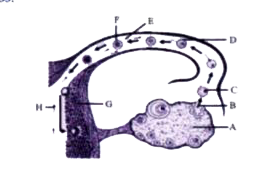How does the production of unisexual flowers prevent self-pollination?
Step-by-Step Solution:
1. Understanding Unisexual Flowers: Unisexual flowers are those that contain either male (staminate) or female (pistillate) reproductive parts, but not both. This means that a flower will either produce pollen or ovules, but not both.
2. Separation of Reproductive Parts: In plants that produce unisexual flowers, the male and female flowers are typically found on different plants (dioecious species) or on different parts of the same plant (monoecious species). This physical separation is crucial in preventing self-pollination.
3. Mechanism of Pollination: Since unisexual flowers do not have both male and female reproductive structures in the same flower, pollination cannot occur within the same flower. For fertilization to happen, pollen must be transferred from a male flower to a female flower.
4. Encouragement of Cross-Pollination: The requirement for pollen transfer between different flowers encourages cross-pollination. This means that pollen from one plant fertilizes the ovules of another plant, leading to greater genetic diversity.
5. Conclusion: Therefore, the production of unisexual flowers prevents self-pollination by ensuring that male and female reproductive parts are separated, necessitating the involvement of external agents (like wind or insects) to facilitate pollination.
Topper's Solved these Questions
- BOOK - CENGAGE BIOLOGYCHAPTER - REPRODUCTIONEXERCISE - MANDATORY EXERCISE (EXERCISE SET III)33videos
REPRODUCTION
- BOOK - CENGAGE BIOLOGYCHAPTER - REPRODUCTIONEXERCISE - CONSOLIDATED EXERCISE9videos
REPRODUCTION
- BOOK - CENGAGE BIOLOGYCHAPTER - REPRODUCTIONEXERCISE - MANDATORY EXERCISE (EXERCISE SET I)23videos
REPRODUCTION
- BOOK - CENGAGE BIOLOGYCHAPTER - NUTRITION IN PLANTS AND ANIMALS EXERCISE - CHALLENGING EXERCISE4videos
NUTRITION IN PLANTS AND ANIMALS
- BOOK - CENGAGE BIOLOGYCHAPTER - RESPIRATION IN PLANTS AND ANIMALS EXERCISE - CHALLENGING EXERCISE1videos
RESPIRATION IN PLANTS AND ANIMALS
Similar Questions
Draw and label : A human sperm
03:38View Solution
Give labels for parts A, E and G respectively.04:19View SolutionDefine the reproduction
02:59View Solution(A) Describe peristalsis and explain why it is necessary for digestion.
(B) Explain why eating high fiber foods can help prevent constipation.02:50View SolutionKrebs cycle
03:52View SolutionUnisexuality of flowers prevents
05:33View SolutionFlowers preventing self pollination is called
02:50View Solutionपुष्पों द्वारा स्व - परागण रोकने के लिए विकसित की गई दो कार्यनीति का विवरण दें ।
View Solutionपुष्पी पादपों में स्व-परागण रोकने के लिए विकसित किन्ही दो युक्तियों का वर्णन कीजिए ।
04:20View Solutionपुष्पों में स्व परागण को रोकने की दो युक्तियों का वर्णन कीजिए।
03:26View SolutionMention two strategies evolved to prevent self-pollination in flowers.
03:33View Solutionपुष्पों द्वारा स्व-परागण रोकने के लिए विकसित की गई दो कार्यनीति का विवरण दीजिए |
03:35View SolutionGive an account of two strategies developed by flowers to prevent self-pollination.
00:54View SolutionMention two strategies evolved to prevent self -pollination in flowers .
02:07View Solutionस्वपरागण रोकने वाले पुष्पों को क्या कहते हैं
03:38View SolutionUnisexuality of flowers prevents
04:31View Solution

